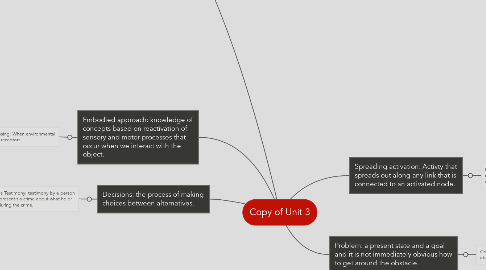
1. Mirror neurons: by curious learning neurons
1.1. Restructuring: process of changing a problems representation
1.1.1. This connects to mirror neurons by try to reconstruct a behavior or a certain problem that may be different from yours. You may be trying to copy a certain dance move and you may have to restructure what you know and change it imitate that particular dance move.
1.1.1.1. This connect to everyday life because we restruct almost everything we do, and we are constantly learning and imitating things. I restructure how I study all the time, I learn new ways and constantly restructure what methods I am using to study.
2. Embodied approach: knowledge of concepts based on reactivation of sensory and motor processes that occur when we interact with the object.
2.1. Bottom-up processing: When environmental energy stimulates receptors
2.1.1. This connects to Bottom-up by using the environment to using bodies to adapt and survive in the world around us. An example of this would be A person using a hammer, they are physically touching the hammer itself and being aware of the outcome like its noise, color, and shape.
2.1.1.1. This relates to everyday life by being out in town and being aware of what is around you and being able to use resources like a cab, map, telephone booth, or people to help you get by.
3. Decisions: the process of making choices between alternatives.
3.1. Eyewitness Testimony: testimony by a person who was present t a crime about what he or she saw during the crime.
3.1.1. The connects to decisions because when the witness is asked what occurred they have to go based on of memory and sometimes it isn't the best in the situation. You may be thinking one thing happened from another thing happened. You have to then decide what is you think happened. It also may be the opposite case, where immediately you are sure of what has happened and you decide to give that statement.
3.1.1.1. This connects to everyday life because we make decisions everyday, such as picking out an ice cream flavor, to deciding on a major, to deciding what information to take from people.
4. Spreading activation: Activty that spreads out along any link that is connected to an activated node.
4.1. Priming: when the presentation of one stimulus changes the a person responds to another stimulus.
4.1.1. This connects to with spreading activation by when we see you see an object you connect it with another item, wheather is it a simple or complex connect. You see a car it can be connected with tires or see a bird and connect it to a robin.
4.1.1.1. This connects to everyday life because we prime everyday things even if we don't realize it. When I see my textbook st home i prime it with a quiz or a test.
5. Problem: a present state and a goal and it is not immediately obvious how to get around the obstacle.
5.1. Concepts: the meaning of objects, events, and abstract ideas
5.1.1. This connects to concepts because we can take on a problem if we do not even understand the problem in the first place. We need to understand what the issue is in order to take the appropriate action. If you do not know much about marrriage and it's new to you you may not be able to resolve identify the clear problem as quickly.
5.1.1.1. This connects to everyday life because we solve problems everyday. We solve problems pertaining to people, money, work, and much more. If we cannot gasp the concept of the problems in everyday life we won't get very far.
